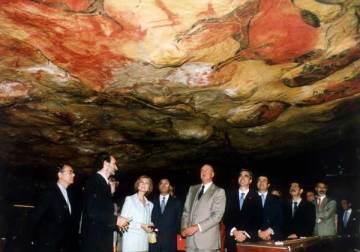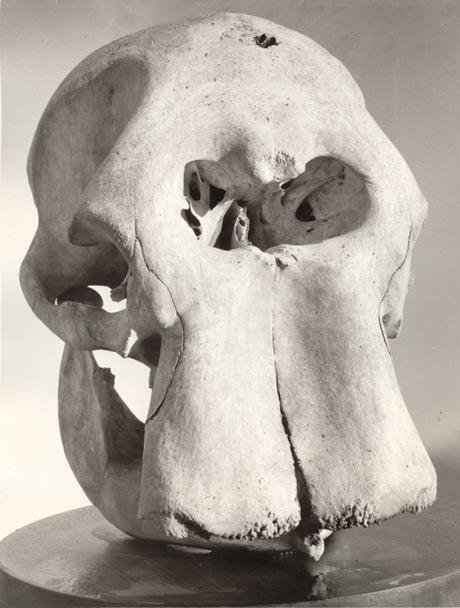In 1879 Marcelino Sanz de Sautuola was conducting an archaeological excavation of the entrance to Altamira Cave, Spain. He’d just returned from a French conference on prehistory and was determined to make some discoveries of his own. Whilst he uncovered some Magdalenian tools (which we now know date to ~15,000 years ago) it was his daughter who made the most significant discovery. Playing in the next chamber, she called to her father claiming she’d found bulls. Sure enough, on the ceiling of the cave were over 30 massive paintings of bulls each drawn on an outcrop of rock to make them appear 3-dimensional.

The “polychrome chamber”, with some people in it for scale
Knowing that the cave was inhabited during prehistoric times Sautola quickly realised that this artwork was also prehistoric. Yet when he presented these findings to the scientific community they were almost universally rejected. Most dismissed them as simply recent images drawn in a prehistoric cave, but others went further and accused Sautola of forgery Some even suggested he was perpetrating a deliberate creationist hoax to refute evolution! It was over 20 years before Sautola’s conclusions were vindicated, but by then he had sadly died.

Other pre-scientific ideas include the interpretation of elephant skulls as that of a Cyclops, with the central trunk-hole being mistaken for an eyesocket
This was not the first time people had made ridiculous claims concerning cave art. In the 14th century the Vatican issued a papal decree condemning the art as Satanic. This may have been because locals were engaging in non-Christian rituals in the caves or because they were believed to be the work of the devil himself, the decree is not clear on the specifics.
The key difference is that the people examining Sautola’s claim were supposed to be scientists, not church members afraid of anything that wasn’t overtly Christian. In 1860 Lartet and Christy had published an account of the first large scale scientific excavations in Europe, conclusively showing that an ancient stone age preceded recorded history. Many others followed and a comprehensive record of the past 50,000 years of human existence was established. This was a golden age in which countless discoveries were made and scientific techniques refined.
So why did they so foolishly reject Altamira as ancient? Some suggest it was simply nationalistic pride since most prehistorians were French whilst Altamira was a Spanish site. It’s certainly telling that the first sites to finally “prove” cave art was ancient were found in France. However, I think the problem was far more pervasive: they didn’t know how little they knew.
Archaeologists had uncovered the past 50,000 years of human existence in Europe but they had no way of knowing they only had 50,000 years of history. They believed they’d discovered it all and so were forced to fit the entirety of human evolution into a tiny fragment of the past. This resulted in many misinterpretations, the most famous being the neanderthals who were faultily assumed to be dim, hunchbacked ape-like ancestors because the incomplete record demanded they be.

The misinterpretaiton of neanderthals had some…interesting implications.
Even the humans they found were classified as the “primitive” Cro-Magnon man despite the fact they’re fully modern in every respect. When evidence began to emerge that these “early” ancestors were in fact much more human-like it was typically rejected out of hand. This is where the rejection of ancient cave art stemmed from. They believed that people from the period were primitive and the idea they could make art challenged this idea to the core and so they rejected it out of hand.
Of course, we now know that most this artwork was created by fully modern humans during the Upper Palaeolithic, between 40,000 and 12,000 years ago. Thus the fact it is developed is no real issue because its manufacturers were too! Despite this there were are still traces of this old way of thinking in modern science. For example, despite the fact that there’s nothing which can really separate “Cro-Magnon man” from modern humans people continue to refer to them in research, news stories and books.
Whilst it can be tempting to sweep these embarrassing episodes under the rug I think they should be embraced, for they remind us of the need for due diligence, skepticism and awareness of our cultural and historical biases. Crucially, they remind us that we should be aware of how little we know and the possibility that our ideas concerning the gaps in our knowledge can be wrong.
Meanwhile real creationists continue to hold up Altamira and other cave art sites as evidence “Cro-Magnon” man was really advanced and not a transitional ape-man!
Bahn, P. 1998. The Cambridge Illustrated History of Prehistoric Art. Cambridge: Cambridge University Press

